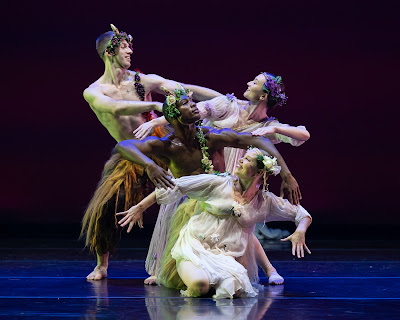A golden reprise: Dance Kaleidoscope opens 50th season with 'Carmina Burana'
Usually trying to project a fresh perspective on theatrical and musical works I've blogged about before,
 |
| Up jumps spring: Stuart Lewis, Paige Robinson, Kieran King, Marie Kuhns |
I avoided first reading my review of the last time Dance Kaleidoscope performed David Hochoy's scintillating version of "Carmina Burana." The perennially popular 1937 cantata by Carl Orff brought to modern music 13th-century secular poetry found in the south German monastery of Benediktbeuren.
I hope it won't be seen as laziness that I invite readers of this entry to call up my 2014 review, especially if they would like to see this show today through Sunday. My attempt eight years ago to detail Hochoy's vision in words I cannot put better now. Orff's style in this work, which he was to pursue from then on after the fierce modernism of his youth, is rhythmically lively, melodically seductive and explicitly aimed toward immediate understanding. Hochoy's vision departs fruitfully from the texts sometimes and addresses the verbal meaning obliquely elsewhere.
The score is the guide: "O Fortuna," the severe invocation to the enduring reign of blind luck over human life, is given a cathedral setting when it first appears. The dancers are helmeted and initially turn their backs on the audience. Reprised at the end, "O Fortuna" carries forward the atmosphere of joy from the immediately preceding music. There is triumph about the wide, face-forward stance of the company, even though the text laments "this detestable life." It's not as though Hochoy has taken a wrong turn here: the bright light of the "daytime" first act returns in the music, too, underscored by costuming that crowns the dancers with halos. They are angels free of any Judeo-Christian theology. Clearly, they invite us to seek causes for celebration in this world even as we rue the powers that exercise capricious control over us.
But I want to add a few things that struck me anew about Thursday's opening night with the current company on the mainstage of Indiana Repertory Theatre.
*The flow and precision of the ensemble dancing reaches a pinnacle in this setting. It replicates the force of the choral portions of Orff's work, which dominate the vocal solos, as intense and sometimes bizarre as they may be. "Carmina Burana," despite its origin in lyric poetry from anonymous sources, puts the individualism of these poems in a restless, communal context. The distance the dancers cover over the course of the work could almost be measured in miles. The scenario is often humanity on the run, but the message essentially is "we're all in this together." The choreography here shows collective virtuosity, both in small groups and in the sweep of the entire company.
*The costuming by Barry Doss emphasizes the dancers' command over space. Whether worn or waved, it gives a special breadth
 |
| That's a wrap: Paige Robinson in "Carmina Burana" |
to every gesture. The episode after the opening chorus makes spectacular use of long white cloths, climactically focused on a central dancer (Paige Robinson), wrapped in (pun intended) kaleidoscopic patterns resembling origami.
*There is no anxious historicism about the way the dancers look in either movement or costuming. There are pagan suggestions in the portrayal of nascent spring, the men resembling satyrs, but this is not Daphnis et Chloe, another landmark in Hochoy's career as artistic director. Medieval strictures are not emphasized visually, thus echoing the freedom the Goliard poets must have felt in composing their literally profane verses.
*Swerves from what the cantata presents: I liked the setting Hochoy devised for a small group of female dancers to go with the children's chorus' brief appearance in the score. It's like a song of innocence plopped down in the midst of songs of experience. And once again, Hochoy's casting aside any temptation to mickey-mouse the celebration of universal binge-drinking is to be applauded. Finally, the song of the roasted swan is reconceived to emphasize human cruelty to our own kind rather than allowing the lament of the painfully turning bird to tickle our fancy.
*Yet again, Laura E. Glover's lighting makes every outline clear, always complementing the choreography's statuesque moments as well as the most exuberant ones. Her freedom from literalism works hand in glove with the richness of the choreographer's imagination.
[Photos by Lora Olive]



Comments
Post a Comment